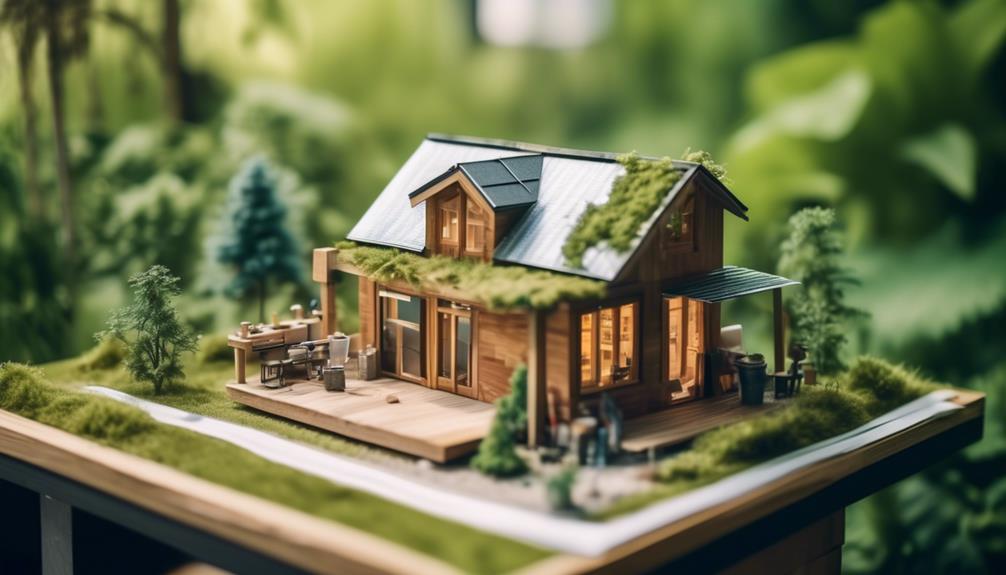In the compact world of tiny homes, size matters just as much as quality, and finding a builder who excels at both is your key to a successful project. You're not just choosing a contractor; you're selecting a partner who will help translate your dream of minimalist living into a tangible, cozy abode.
As you embark on this journey, you must consider their credentials, scrutinize their portfolio, and ensure their communication style aligns with your expectations. It's about striking the perfect balance between skill, reliability, and a shared vision for your space-efficient haven.
Let's navigate the nuances of this selection process together, and by the end, you'll have a clearer roadmap to a builder who doesn't just construct houses but builds homes that resonate with your identity.
Key Takeaways
- Scrutinize builder credentials and experience, including compliance with building codes, industry standards, certifications, and training programs.
- Evaluate the builder's portfolio for experience, skill, functional and aesthetically pleasing homes, alignment with your vision, and ability to meet the unique demands of the tiny house community.
- Understand the construction process, including the builder's capability to shepherd the project, adherence to building codes and timeline, and insight into the stages of construction.
- Assess communication and customer service, including responsiveness, listening to and addressing needs, promptness in addressing queries, transparency in communication, and engagement with the Tiny House Enthusiasts Group.
Assessing Builder Credentials
When selecting a tiny home builder, it's critical to scrutinize their credentials to ensure they possess the necessary certifications, comply with local building codes, and adhere to stringent safety and industry standards. Opt for an experienced Tiny House builder whose construction experience is evident through a portfolio of past projects.
The best Tiny House builders will readily present their builder credentials, showcasing approved training programs and certifications that affirm their expertise. Assess if their construction methods incorporate quality materials, and if they've a robust guarantee/warranty policy that aligns with your unique needs.
Comparing Portfolio Quality
After assessing a tiny home builder's credentials, it's equally important to examine their portfolio quality, as this reflects their experience and skill in creating homes that are both functional and aesthetically pleasing. A top-tier portfolio is your window into the builder's craftsmanship, showcasing the best construction techniques and innovative design solutions they have employed. When choosing a builder, consider how their previous projects align with your vision for a tiny home and their ability to meet the unique demands of the tiny house community.
| Project | Building Materials | Design Innovation |
|---|---|---|
| Home A | Reclaimed wood | Rooftop garden |
| Home B | Lightweight steel | Foldable furniture |
| Home C | Energy-efficient insulation | Multi-use fixtures |
| Home D | Sustainable bamboo | Integrated technology |
| Home E | High-grade lumber | Custom storage solutions |
Dive deep into the details; premium materials, meticulous attention to detail, and a portfolio quality that exudes excellence are non-negotiable for your future haven.
Understanding Construction Process

To fully grasp the construction process of a tiny home, you must first delve into the meticulous planning stage, which lays the groundwork for all subsequent steps and ensures that your vision for a compact living space is achievable within the set timeline and budget.
When you choose the right tiny home builder, it's crucial to analyze their capability to shepherd your project from pre-construction—securing permits and finalizing designs—to the complexities of on-site or shop facilities building.
Each phase, from construction to the critical inspections, demands a builder with a keen eye for custom details. As different builders follow varied protocols, make sure you understand how your tiny house is built to ensure adherence to codes and your project timeline.
Insight into these stages will illuminate the path to your tiny home's completion.
Evaluating Communication Styles
When you assess the responsiveness levels within your team, you're pinpointing who jumps into action and who prefers contemplation before responding.
Understanding the clarity of information shared among your team members is crucial; it ensures that everyone is on the same page, mitigating the risk of costly misunderstandings.
Assessing Responsiveness Levels
Evaluating a tiny home builder's communication style is essential, as it provides insight into their ability to effectively listen to, understand, and address your needs throughout the construction process.
As a tiny house lover looking for custom solutions, you want a builder for your project who's not just among the best tiny house manufacturers but also excels in responsiveness.
When choosing a tiny house, observe how top tiny house builders interact with you. Are they prompt in addressing your queries? Do they communicate with transparency and clarity?
The right tiny home partner doesn't just make a house—they make sure every detail reflects your vision. Therefore, an analytical approach to assessing responsiveness levels can significantly influence the outcome of your tiny homes' design and construction.
Understanding Information Clarity
Assessing a tiny home builder's communication style requires a keen understanding of how they convey information, ensuring it's not only clear but also tailored to your unique needs and level of comprehension. When diving into the Tiny House Movement, the way information is presented can significantly impact your ability to make an informed decision. Here are key points to evaluate:
- Does the builder provide an Ultimate Guide to Tiny House specifics, breaking down complex concepts?
- Are updates from start to finish communicated effectively, keeping you in the loop?
- How does the builder engage with the Tiny House Enthusiasts Group, reflecting their years of building expertise?
You'll want to find the best partner who can discuss the right tiny house exterior and enjoy a seamless project journey.
Considering Customization Options

You'll find that customizing your webpage with personalized JavaScript or CSS not only enhances its functionality but also elevates its aesthetic, making your online presence uniquely yours.
Delving into the world of Tiny House customization, it's imperative to consider the breadth of options available.
From selecting the right tiny house heater to crafting an amazing tiny house exterior, the customization options are vast for house lovers seeking innovation.
Analyzing Client Testimonials
Having explored the array of customization options for your tiny house, let's now turn our attention to what previous clients have to say, as their testimonials are a critical source of information on the performance and trustworthiness of tiny home builders.
When analyzing client testimonials, consider:
- Consistency: Are there recurring positive comments about the Tiny House Exterior or the passion for Tiny details?
- Specificity: Do reviews highlight unique Tiny House ideas that made their home the best-looking house in their view?
- Credibility: Are the testimonials diverse and from credible sources that help you find Tiny Houses that truly resonate with your vision?
Dive deep into these testimonials. They offer an authentic glimpse into what it's like to work with the right tiny home builder and reflect the satisfaction of Tiny House lovers like yourself.
Frequently Asked Questions
How Do I Find the Right Tiny House?
To find your ideal tiny house, consider your design preferences, sustainability desires, and mobility needs. Research builders' reputations and customization options, mindful of zoning challenges and the community lifestyle you're aiming for.
Is It Hard to Get Approved for a Tiny Home?
Navigating the maze of approval challenges, you'll face zoning issues and strict building codes. Financing options vary, with diverse loan types and credit requirements affecting your journey. Consider customization limitations and insurance policies carefully.
Which State Is Most Tiny Home Friendly?
You'll find states like Oregon and Colorado most tiny-home friendly, as they offer relaxed zoning regulations, communities embracing sustainability, ample land, and favorable climate considerations that align with a pioneering, eco-conscious lifestyle.
How Much Can I Afford for a Tiny House?
Your financial roadmap to tiny living hinges on meticulous budget planning, blending living essentials with space optimization. Prioritize design customization, material costs, and a downsize strategy, ensuring your minimalist lifestyle includes sustainable features and manageable utility expenses.
Conclusion
In choosing your tiny home titan, prioritize proficiency and personal rapport. Scrutinize their skill set, savor the style showcased in their portfolio, and seek clarity on construction chronology.
Engage earnestly to ensure expectations are echoed, and customization capacities can cater to your creative cravings. Finally, filter through feedback fervently; client commendations are critical.
Your diligence in dissecting details will direct you to a dream dwelling designer, deftly dedicated to developing your diminutive domicile with distinction.

